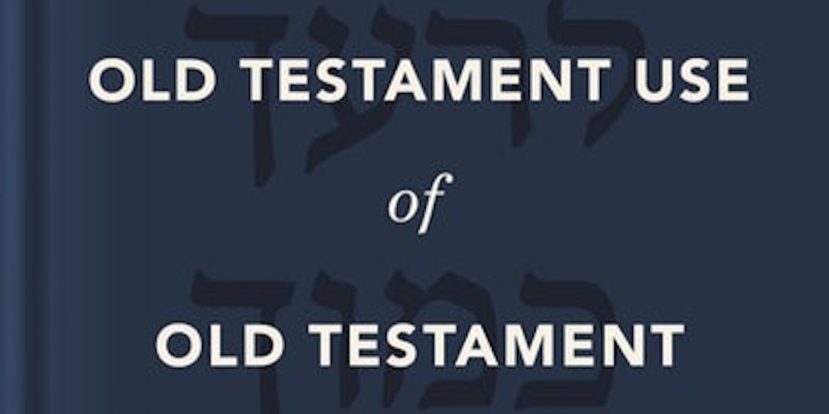
Surprises of Old Testament Use of Old Testament: Part 4
The posts of this series present surprises that came out researching and writing a reference work for students and ministers of the word on the use of scripture within Israel’s scriptures entitled Old Testament Use of Old Testament.[i] (See parts one, two, and three.)
Even before the years of formal research for the reference work, I had been studying scriptural exegesis within Israel’s scriptures for decades. Many of my seminary courses include research projects in which students work on cases of scriptural interpretation within the Hebrew scriptures from lists that I provide for them. I have long been debating about and wrestling with scriptural exegesis within Israel’s scriptures at conferences and in the classroom. In spite of extended study of the Bible’s use of the Bible the research for this project led to some unexpected findings.
Unexpected Observation Four: New Testament Use of Old Testament
I was surprised by how often the authors of the New Testament gravitate toward scriptural exegesis within Israel’s scriptures. The author to the Hebrews provides a convenient example of a widespread tendency. The author to the Hebrews frequently works with teachings from the Torah that had been interpreted by the prophets and psalmists. He refers to the creation of humans by citing Psalm 8. He speaks of Melchizedek by quoting Psalm 110. He uses the rebellion in the wilderness as analogy by means of Psalm 95. He explains tabernacle sacrifice by Psalm 40. He gets at the failure of the Mosaic covenant by working with Jeremiah 31.[ii] When New Testament authors, like the author to the Hebrews, use pre-interpreted scriptural contexts, they shine a light on progressive revelation. Scriptural exegesis of scripture displays progressive revelation in action.
In many places New Testament teachers and authors use contexts from Israel’s scriptures that include within them exegesis of still earlier scriptural revelation. Messiah and the apostles repeatedly cite: “Love thy neighbor.” Messiah pushes back against his opponents with the example of the high priest giving the bread of the presence to David. Each of the four evangelists borrow Isaiah’s new exodus to frame the gospel. All four evangelists allude to Zechariah’s oracle of the king coming upon a donkey. Messiah quotes Isaiah’s oracle that Yahweh’s temple shall be a house of prayer when he clears the court of the gentiles. James looks back to Amos’ promise of the restoration of the shelter of David to determine how to handle gentile conversions. Paul alludes to Joel’s oracle to get at the inclusion of Jews and gentiles who call upon the name of the Lord.[iii] All of these contexts of Israel’s scriptures—and many more—are examples of scriptural exegesis within Israel’s scriptures. Scriptural exegesis of scripture displays progressive revelation in action. Click To Tweet
When a passage of Israel’s scriptures exegetically alludes to another scriptural passage, then this connection may be considered part of the context—context by allusion. If the paragraph or chapter surrounding the cited passage is its horizontal context, then the exegetical allusion to another scriptural context within the passage is its vertical context. Anyone familiar with studies of the New Testament use of scripture hardly needs to be told that vertical context has been almost entirely ignored.[iv] Old Testament allusions to other Old Testament texts are not add-ons, they are part of the context. In this way, evaluating scriptural exegesis within Israel’s scriptures offers significant opportunity to increase outcomes in studying the New Testament use of scripture. One example can illustrate the importance of vertical context. Since I have explained the details at some length elsewhere an abbreviated summary will suffice.[v]
Zechariah 9:9 as Prequel and Mark 11:1-10 as Set Up to Ironic Sequel
When Mark presents Messiah entering Jerusalem on a donkey he does more than make allusion to the expectation of the coming humble and saved king in Zechariah 9:9. Mark speaks of the donkey using “bound” twice and “unbinding” three times.[vi] This emphasis naturally draws attention to the expected Judah-king “binding” his donkey to a vine in the blessing of Judah.[vii] Zechariah’s oracle of the coming king connects to the blessing of Judah by revealing what comes before the arrival of the king upon his donkey. Just as Zechariah advances revelation by offering an exegetical prequel to the blessing of Judah, so too Mark further advances revelation with as ironic sequel to Zechariah’s prequel.[viii]
| Prequel
Humble king comes riding on a donkey (Zechariah 9:9) |
Blessing of Judah
Judah-king enters his vineyard with his donkey (Genesis 49:11) |
| Triumphal entry
Messiah comes riding on a donkey (Mark 11:1-10) |
Sequel
Son of vineyard owner executed as king of the Jews (Mark 12:1-11; 15:26) |
Maybe I should not be surprised. In some ways, it is natural that scriptural exegesis breeds scriptural exegesis. Yahweh saw fit to advance some of his revelation incrementally by means of scriptural exegesis of scripture. In this way revelatory advances by means of scriptural exegesis in the Old Testament move toward the gospel of Messiah step by step.
Footnotes
[i] See Gary Edward Schnittjer, Old Testament Use of Old Testament (Grand Rapids: Zondervan Academic, at press).
[ii] See Heb 2:6–8 (Ps 8); 7:17–21 (Ps 110:4); 3:7–11 (Ps 95); 10:5–7 (Ps 40); 8:8–12; 10:16–17 (Jer 31). These examples in Hebrews come from Gary Edward Schnittjer, “The Blessing of Judah as Generative Expectation,” Bibliotheca Sacra 177 (2020): 36.
[iii] See, e.g., Luke 10:36; Rom 13:8–10; Luke 6:3–4; Matt 3:3; Mark 1:2–3; Luke 3:4–6; John 1:23; Matt 21:5; Mark 11:2–5; Luke 19:30–35; John 12:15; Mark 11:17; Acts 15:16–18; Rom 10:13.
[iv] See Schnittjer, OT Use of OT, chap. on Toward the New Testament.
[v] See ibid., note on Zech 9:9; Schnittjer, “Blessing of Judah,” 27–30, 35.
[vi] See Mark 11:2, 4, 5.
[vii] See Gen 49:11.
[viii] Table adapted from Schnittjer, “Blessing of Judah,” 29–30.

